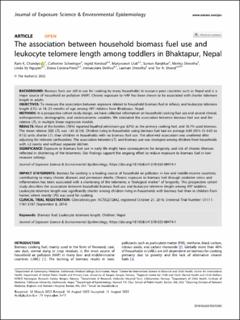| dc.contributor.author | Chandyo, Ram Krishna | |
| dc.contributor.author | Schwinger, Catherine Monika | |
| dc.contributor.author | Kvestad, Ingrid | |
| dc.contributor.author | Chandyo, Manjeswori Ulak | |
| dc.contributor.author | Ranjitkar, Suman | |
| dc.contributor.author | Shrestha, Merina | |
| dc.contributor.author | Nguyen, Linda Vy | |
| dc.contributor.author | Corona-Perez, Diana | |
| dc.contributor.author | DeVivo, Immaculata | |
| dc.contributor.author | Shrestha, Laxman | |
| dc.contributor.author | Strand, Tor Arne | |
| dc.date.accessioned | 2022-12-30T08:04:29Z | |
| dc.date.available | 2022-12-30T08:04:29Z | |
| dc.date.created | 2022-10-16T12:46:00Z | |
| dc.date.issued | 2022 | |
| dc.identifier.issn | 1559-0631 | |
| dc.identifier.uri | https://hdl.handle.net/11250/3040002 | |
| dc.description.abstract | Background Biomass fuels are still in use for cooking by many households in resource poor countries such as Nepal and is a major source of household air pollution (HAP). Chronic exposure to HAP has been shown to be associated with shorter telomere length in adults. Objectives To measure the association between exposure related to household biomass fuel in infancy and leukocyte telomere length (LTL) at 18–23 months of age among 497 children from Bhaktapur, Nepal. Methods In a prospective cohort study design, we have collected information on household cooking fuel use and several clinical, anthropometric, demographic, and socioeconomic variables. We estimated the association between biomass fuel use and the relative LTL in multiple linear regression models. Results Most of the families (78%) reported liquified petroleum gas (LPG) as the primary cooking fuel, and 18.7% used biomass. The mean relative (SD) LTL was 1.03 (0.19). Children living in households using biomass fuel had on average 0.09 (95% CI: 0.05 to 0.13) units shorter LTL than children in households with no biomass fuel use. The observed association was unaltered after adjusting for relevant confounders. The association between LTL and biomass use was strongest among children from households with ≤2 rooms and without separate kitchen. Significance Exposure to biomass fuel use in early life might have consequences for longevity, and risk of chronic illnesses reflected in shortening of the telomeres. Our findings support the ongoing effort to reduce exposure to biomass fuel in low-resource settings. Impact statements Biomass for cooking is a leading source of household air pollution in low and middle-income countries, contributing to many chronic diseases and premature deaths. Chronic exposure to biomass fuel through oxidative stress and inflammation has been associated with a shortening of the telomeres, a “biological marker” of longevity. This prospective cohort study describes the association between household biomass fuel use and leukocyte telomere length among 497 toddlers. Leukocyte telomere length was significantly shorter among children living in households with biomass fuel than in children from homes where mainly LPG was used for cooking. | en_US |
| dc.language.iso | eng | en_US |
| dc.publisher | Nature | en_US |
| dc.rights | Navngivelse 4.0 Internasjonal | * |
| dc.rights.uri | http://creativecommons.org/licenses/by/4.0/deed.no | * |
| dc.title | The association between household biomass fuel use and leukocyte telomere length among toddlers in Bhaktapur, Nepal | en_US |
| dc.type | Journal article | en_US |
| dc.type | Peer reviewed | en_US |
| dc.description.version | publishedVersion | en_US |
| dc.rights.holder | Copyright 2022 The Author(s) | en_US |
| cristin.ispublished | true | |
| cristin.fulltext | original | |
| cristin.qualitycode | 2 | |
| dc.identifier.doi | 10.1038/s41370-022-00474-1 | |
| dc.identifier.cristin | 2061713 | |
| dc.source.journal | Journal of Exposure Science and Environmental Epidemiology | en_US |
| dc.relation.project | Norges forskningsråd: 223269 | en_US |
| dc.identifier.citation | Journal of Exposure Science and Environmental Epidemiology. 2022. | en_US |

